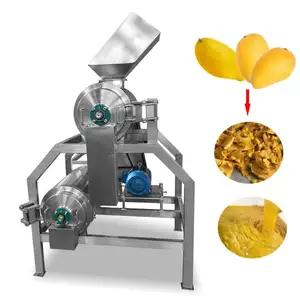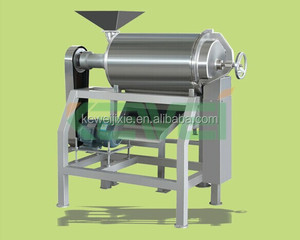(2333 products available)






























































































































































































































Typically salient in the food processing industry, tomato puree making machines are engineered to convert whole tomatoes into tomato puree efficiently. These machines come in different types with diverse specifications and designs to meet particular processing needs and scales.
Cutting and crushing machines
Usually the first step of puree production, these machines are designated to cut, crush, or mash tomatoes to create a consistent mixture as the foundation for the puree. Generally, this allows for further processing steps, such as cooking and straining, to occur easily. As the name suggests, the primary focus of these machines is to cut tomatoes into smaller pieces or crush them into a pulp. This release of juices and fibers is fundamental to producing tomato puree.
Tomato washing and sorting machines
These are typically the first steps in any tomato product manufacturing line. Before any cutting, crushing, or processing takes place, the tomatoes must be adequately washed and sorted through. As the name suggests, these machines are designed to sort out damaged or unripe tomatoes and wash the tomatoes thoroughly to remove any soil, chemicals, or impurities from their surfaces. Usually, tomato washing and sorting machines are equipped with a gentle washing system that eliminates the need for hand sorting – a process that can be both tedious and time-consuming. These machines often have sorting belts or rudimentary sorting systems that allow workers to quickly identify and remove any flawed tomatoes, ensuring that only the best quality tomatoes are processed further.
Tomato paste extractor machines
These machines are specifically designed to separate the pulp from the skin and seeds of the tomato. Equipped with a sieve or filter, tomato paste extractor machines press cooked tomatoes to extract a smooth puree while retaining skins and seeds. This introduces a valuable feature of the puree production process: the control over the final product's texture. Depending on market requirements, tomato puree can range from a coarse puree containing bits of tomato to a fine puree with a velvety-smooth consistency. Tomato paste extractor machines allow processors to modify the texture of the puree to suit their desires and applications. Moreover, these machines considerably cut the time and physical work necessary to produce tomato puree by hand or with less efficient techniques.
Tomato cooking machines
These machines are designed to cook tomatoes at a particular temperature to release their juice and concentrated flavor, essentially forming the basis of tomato puree. The cooking process is critical in developing the taste of the puree and assisting in the extraction of pulp and juice. Furthermore, heating tomatoes helps inactivating enzymes that can result in undesirable changes in flavor and color over time. Cooking also aids in the breakdown of tomato cell walls, allowing for more efficient extraction of juice and pulp. Consequently, tomato cooking machines typically feature temperature controls that enable food processors to maintain a precise cooking temperature.
Pasteurizing machines
Pasteurizing machines in puree production play a pivotal role in ensuring the product's safety and extending its shelf life. These machines subject the puree to heat treatment, effectively eliminating harmful bacteria and microorganisms.
Tomato paste-making machines have different features based on what they're used for. Key parts include:
To keep tomato paste-making machines working well, they need cleaning and repairs regularly. Here's a maintenance schedule:
Pureed tomatoes are an essential ingredient in many recipes. Tomato puree making machines are used in the following scenarios:
Food processing companies
Food processing companies use industrial-sized puree machines to make tomato puree at a large scale. The puree will be processed into canned tomatoes, tomato sauces, ketchup, and other products. The machine will crush the tomatoes and cook them quickly to remove moisture.
Restaurants and commercial kitchens
Restaurants and larger kitchens use tomato puree machines to prepare fresh tomatoes for sauces, soups, and other dishes. The puree adds flavor to dishes. Chefs prefer machines that are easy to operate and clean.
Small-scale food manufacturers
Small-scale food manufacturers make products like salsa, pasta sauce, and pizza sauce. They will use tomato puree machines to process tomatoes into puree. The manufacturers choose machines that are durable and reliable to produce purees of different flavors.
Farmers and agriculture cooperatives
Farmers can invest in tomato puree machines for on-farm processing. Tomatoes are grown in many farms as they are ideal for crop rotation. Fresh tomatoes can be processed into puree and packaged for local markets.
Catering services and food trucks
Catering services and food truck businesses make dishes and sauces using fresh tomatoes. They will use tomato puree machines to make tomato puree on-site when cooking to reduce waste and offer fresh products.
Research and development labs
Some tomato puree machines have controlled features to allow precise manipulation of variables like temperature and pressure. These purée machines are used in research and development labs to study tomato puree processing. The findings can be used to develop new products and improve existing puree processes.
Production Capacity
When choosing a tomato puree machine, nun buyers should consider the machine's production capacity. The production capacity of the machine will determine how much puree will be produced in a given time. It is important to match the production capacity with the intended use and demand. Industrial-scale operations may require machines with higher production capacities to meet the demands of large-scale processing. On the other hand, smaller-scale operations may find machines with lower production capacities more suitable to meet their needs.
Automation and Control
The automation and control features of a tomato puree machine play a crucial role in determining how the machine should be chosen. Automation simplifies the processing and reduces manual work, allowing for smooth operations. Automation leads to easy and efficient production with little interference. Automation also ensures that the process is consistent and reliable.Hygiene and cleaning are very important in food processing. How to Clean is an Important Consideration When Choosing a Tomato Puree Machine Cleaning Ability C Another important factor to consider is the machine's energy efficiency. Choosing an energy-efficient tomato puree machine can help reduce energy consumption and environmental impact during food processing operations.
Machine Durability
The material chosen for a tomato puree machine has a big impact on its life span.The machine must be able to withstand heavy processing and frequent use, so it is important to match the machine's durability with the food application's demands.The machine's spare parts must be durable and easy to replace,so choosing fast wearing parts will ensure continuous operation and shorten maintenance time.
Cost
Because of the fast-paced world we live in,demanding customers and increasing competition,product costs are of paramount importance and should be considered when determining tomato puree machine costs in this context.A tomato puree machine's upfront costs include its purchase,installation and initial start-up expenses,while ongoing costs include maintenance,repair and replacement of key components.
Q1: How does a tomato puree processing machine work?
A1: The machine works by crushing whole cooked tomatoes into a pulp. It then separates the skin and seeds using a separator. Following this, the pulp is heated and concentrated into tomato puree. Finally, the tomato puree is packaged for storage or sale.
Q2: What are the steps in tomato puree production?
A2: The steps include washing and cutting of the tomatoes, cooking the tomatoes, crushing the cooked tomatoes, separating the pulp from the skin and seeds, heating the tomato pulp to concentrate it, cooling the concentrated puree, and finally, packaging.
Q3: What is the difference between tomato puree and tomato sauce?
A3: Tomato puree is produced by cooking and blending tomatoes into a smooth liquid. It has a thinner consistency and is often used as a base for soups and sauces. On the other hand, tomato paste is made from cooked tomatoes and other ingredients, which gives it a thicker consistency. Tomato paste is usually used for dipping or as a side to dishes.